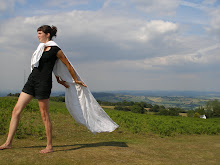
I haven't written a post for so long, it's strange to sit down and do so. I've been doing, not reflecting. At the end of my tour around Italy, I stopped over in France for a week. This was great in itself, strange but fascinating. However, my thoughts about Italy dispersed and I'm sorry to say I let them go. I am writing this just before leaving for France for a month, and I would like to thank Patrick, Will and Lucie who have badgered me to get writing again.
To fill in the blanks a bit, when I came back from Italy/France I had this plan which, like all my plans, I attacked with ferocity and determination. I dug up frozen earth - frozen! It broke the spade but didn't get to my willingness to get something done – and then planted Heritage wheat grains and, as an afterthought, Pink Fir-Apple potatoes. I went on a Princes Trust course to help me make sense of the apparent conflict between making a living and making really good bread; I talked to loads of people about finding somewhere to install or build a bread oven; I worked for a month as a cook (last day tomorrow! Oh, how I shall not miss the jolly 'ding!' of the microwave); I passed my driving test, at last; I built a bread oven...
Actually, the last point on that list sounds waaay more simple than it was: Firstly, any plan of mine begins to topple after a few weeks, undermined by self-doubt; Secondly, the oven is at my parents' house and necessitated the use of an enormous slab of stone as the base, a choice we later regretted and agonised over (Will the heat crack it? Maybe. Have we enough strength to move it again? Maybe not.) My brother Tom and sister Lucie generously helped to lay the refractive brick base, shape the wet sand form (a domed 'sandcastle' that gave the 'positive' of the eventual oven cavity) and then squodge the mud/sand to a workable consistency with their feet for building the first layer of the oven. Thomas has completely huge feet and made sort work of this: Tom, Lu and I ended up looking like Hobbits as the clay mix caked our feet. Layer Two is wood-shavings mixed with mud and – nearly 6 months after we began – Layer Three, straw and mud 'cob', has just been added. Everything chez moi has to be fitted in around a confusion of comings and goings, work, college, visits, book clubs etc., and any project is best approached from the side because to address something directly might frighten it and it will run away down its burrow... or something like that. So that's why it's perfectly reasonable that Ma and I ended up slapping on the 'cob' layer in the dark the other night. We couldn't see anything, and even if we could've I wouldn't have known what to look for. Tonight, though, I lit it because I wanted it to be dry and covered before I go away again.
When I'm in France, I'll sort out pictures of the oven for you. In the meantime, the loaf I've shown here was baked on the base of the Aga a couple of days ago. It is a sourdough and has a really good, slightly glossy, crust because I've been following Elizabeth David's strange-sounding advice: -try tipping an entire glass of water over the bread before shutting the oven door. The puff of seam will give the dough an extra few minutes of stretch before it hardens to a crust and the loaf will balloon. I have done this in an Aga and a gas oven (avoiding the flame) but wouldn't recommend trying it in an electric oven...
However, the Pink Fir-Apple potatoes were a runaway success. I admit that the first few plants I dug up were so rife with enormous, shiny black beatles and slugs as fat and luxuriant as little sea-lions (imagery: thank you Pa Boase) that my brother Will suggested I needed to re-brand my failed gardening as a successful exercise in farming giant pests. The rest of the plants, though, have produced the most gorgeous crop of spuds I've ever seen, and they are the tastiest too. I dig some up in the mist this morning and couldn't stop smiling. (They are also rather comical, being pink and long, and somewhat knobbly.) Now, I remember when I lived in Rome, my favourite pizza al talglio was topped with just olive oil, rosemary and slices of waxy Lazio potatoes. In a mixture this simple, the potatoes really have a chance to show off their own flavour. I think I should give this a try when I get home again...

Good to see you back and writing for your readers, I always tend to learn from experience of others and the information you shared here have many aspects to learn. Thank you for sharing it
ReplyDelete